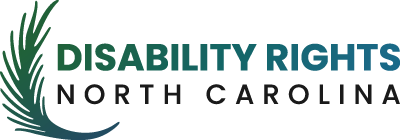Staff post:
Nick Lett
Advocate/Paralegal, NCCP
What is DRNC’s Safe and Secure Schools (SASS) Project?
Imagine your child comes home from school with bruises on her arms and her clothes torn and dirty. When you ask her what happened, she tells you that her teacher held her down on the ground. Or imagine that, without explanation, your child becomes fearful and anxious about going to school. Maybe he refuses to leave the house in the mornings and all your attempts to get him to school are met with defiance and emotional outbursts.
These are realities that many parents of students with disabilities DRNC speaks with face and are signs that a child may be experiencing abuse or neglect at school, such as inappropriate use of seclusion and restraint. Parents often do not know what to do or how to advocate for their student.
If you are concerned about your disabled child being mistreated at school, call Disability Rights North Carolina (DRNC). Our SASS Project, funded by a grant from the North Carolina Governor’s Crime Commission, focuses on addressing abuse and neglect, including the inappropriate use of seclusion and restraint, in North Carolina’s public schools.
What is seclusion?
Seclusion is when school staff put a student alone in an enclosed space and keep them from leaving. This might be accomplished by locking the door or holding it shut. It might also mean the student is physically unable to leave the space (e.g., a student who cannot propel her own wheelchair), or does not understand that he can leave the space.
Schools may use terms like “quiet room,” “time-out” or “being removed to another location” instead of seclusion. Time-out is very different from seclusion, though. Time-out should mean that the student is temporarily separated from his peers, such as in a different part of the classroom or in the hallway – not isolated, alone, in a separate space. Parents who see or hear these terms may want to speak with school staff about what those terms really mean.
The use of seclusion can put a student at risk of physical and emotional injury, so it should only be used as a last resort to prevent serious injury. The law permits schools to use seclusion in certain other situations, and only in rooms that do not contain dangerous objects.
What is a restraint?
A physical restraint is when staff use their hands or body to prevent a student from moving freely. Staff might also call this a “physical hold” or “therapeutic hold.” A mechanical restraint means a device or material that a student cannot easily remove that prevents the student from moving freely. Examples of mechanical restraint include a seatbelt, or a Rifton or other chair with straps or a tray.
Schools are only permitted to use physical or mechanical restraint in limited circumstances. Like seclusion, restraint can lead to physical and emotional injury, and must only be used as a last resort.
What about other types of abuse and neglect in schools?
Inappropriate use of seclusion and restraint can be a type of abuse or neglect when they cause physical or psychological harm. Students with disabilities can also experience other forms of abuse. Teachers may physically strike students as a punishment or to “correct” a student’s behavior. School staff might verbally abuse students. They may neglect a child by withholding food, fail to provide clean clothing to students in soiled pullups or clothing, or fail to accommodate medical services.
Students with disabilities are at an increased risk of abuse and neglect in public schools, because many spend their whole day in separate settings (i.e. self-contained special education classrooms). This limits the number of people that may see or speak to the students, which means that signs of abuse and neglect may go unnoticed. Also, many students can’t communicate with their parents or others about what is happening in their classrooms because of their disabilities.
How DRNC’s SASS Project addresses abuse and neglect
One of the most important tools that DRNC’s SASS Project uses to address abuse and neglect in public schools is conducting investigations based on complaints we receive from parents and the public. Federal law grants DRNC the authority to investigate such complaints, by accessing school buildings, requesting records, and interviewing school staff. This authority is important, because in many instances students with disabilities can’t communicate what is happening to them, and parents have no other way to find out. It is DRNC’s role as a protection and advocacy organization to use our access authority to investigate complaints and protect students with disabilities from abuse and neglect.
The SASS Project uses other tools to help students, too. We have the authority to make visits to public schools to look for abuse, neglect, and the inappropriate use of seclusion and restraint. We can tour school buildings and speak with students. The SASS Project trains parents and professionals about abuse and neglect in schools. We help connect parents with other advocates or help them learn to advocate for themselves.
When to contact DRNC
We encourage anyone who notices possible signs that a child is being secluded, restrained, abused, or neglected at school to contact DRNC. Signs may include:
- Unexplained bruises, cuts, or torn clothes.
- New or worsening behavioral or academic problems.
- Sudden fear of going to school, emotional outbursts and/or refusing to go to school.
Call DRNC at 919-856-2195, or submit an online application for help. An Intake Advocate will take your call or schedule a time to get more information from you. They will then pass your information on to the SASS Project staff for follow-up.
